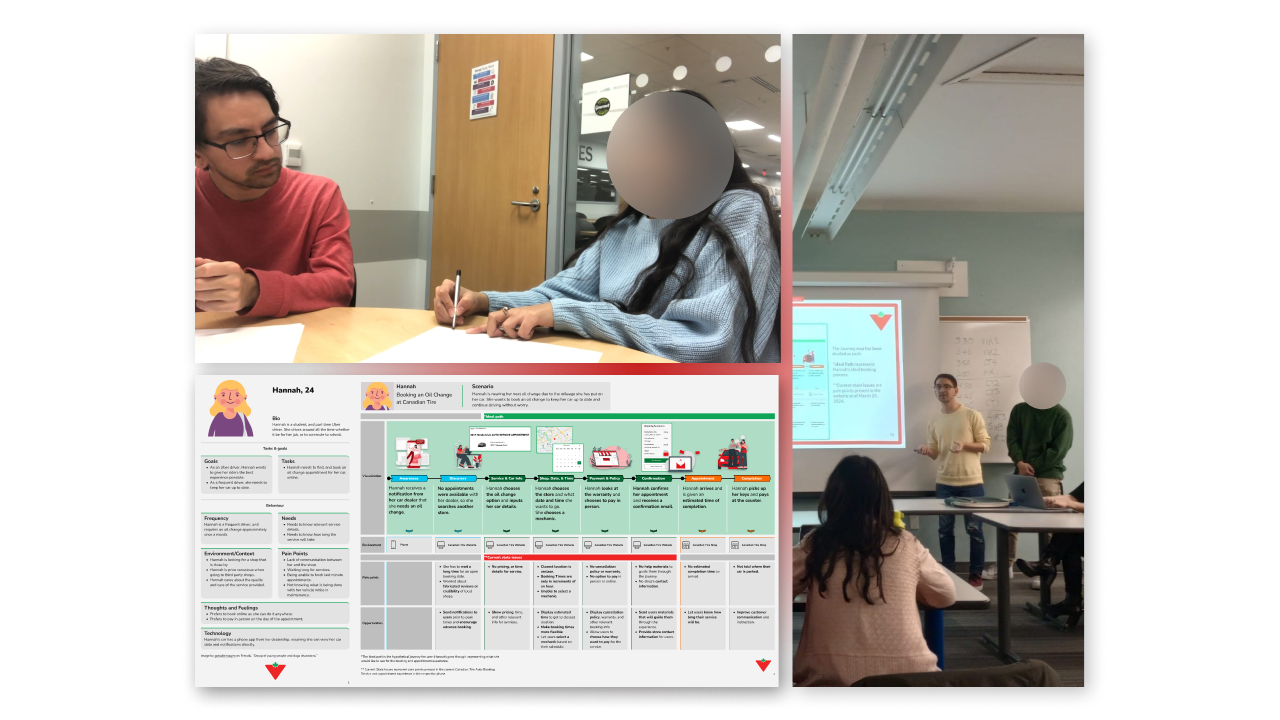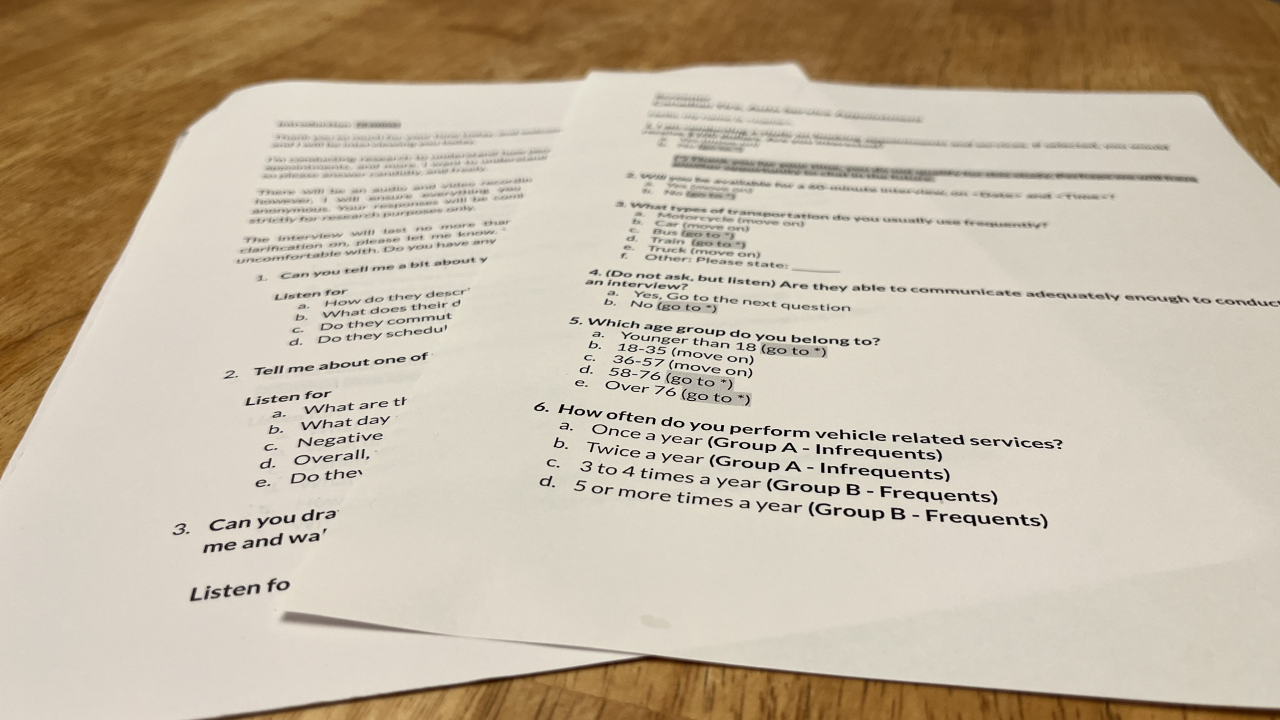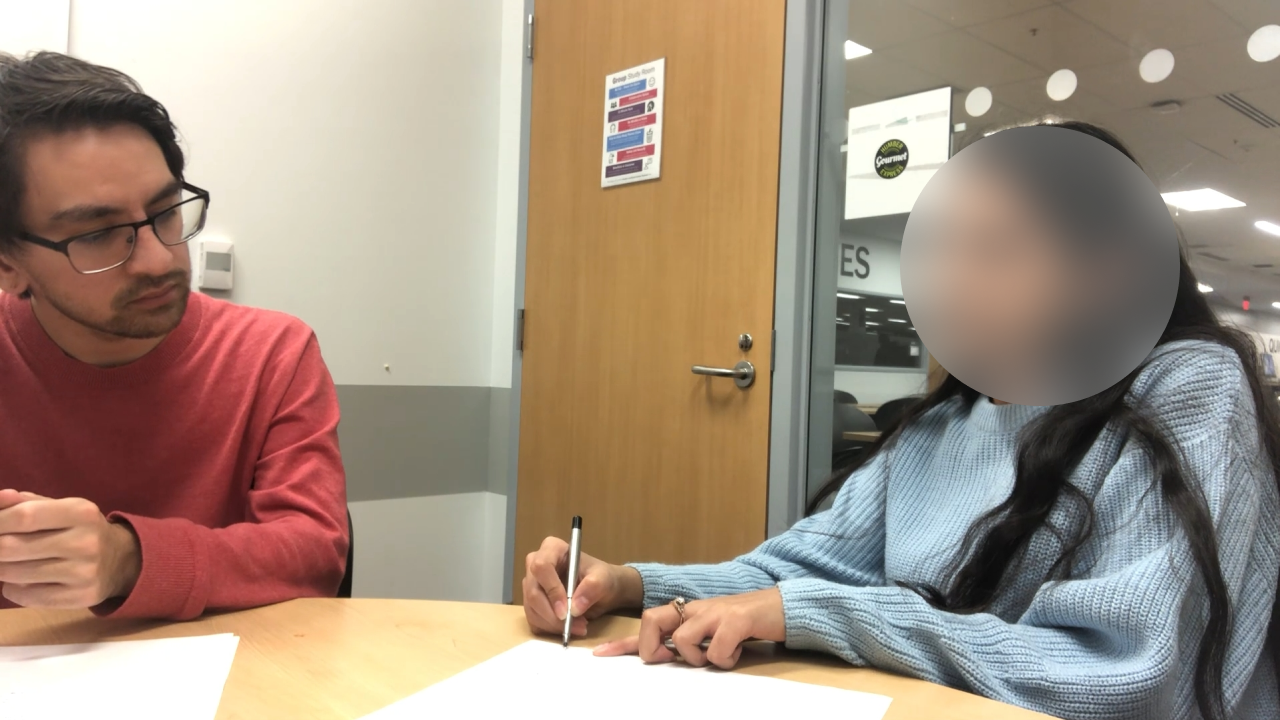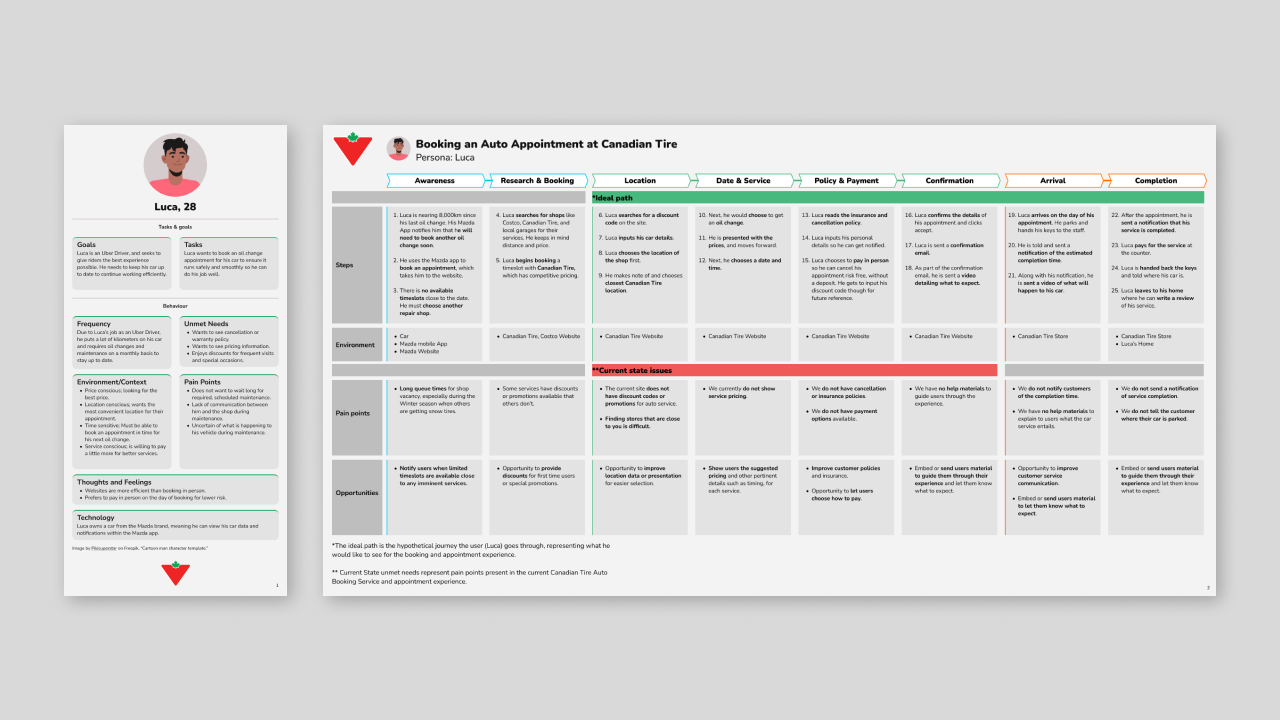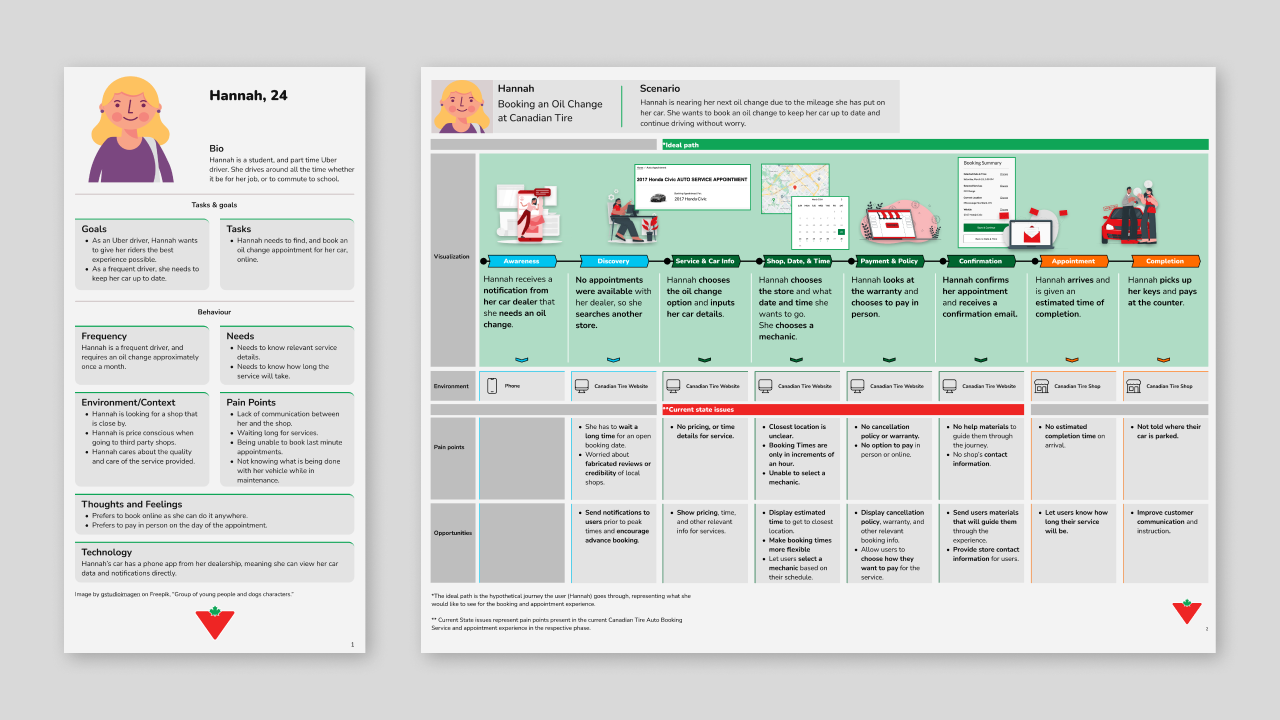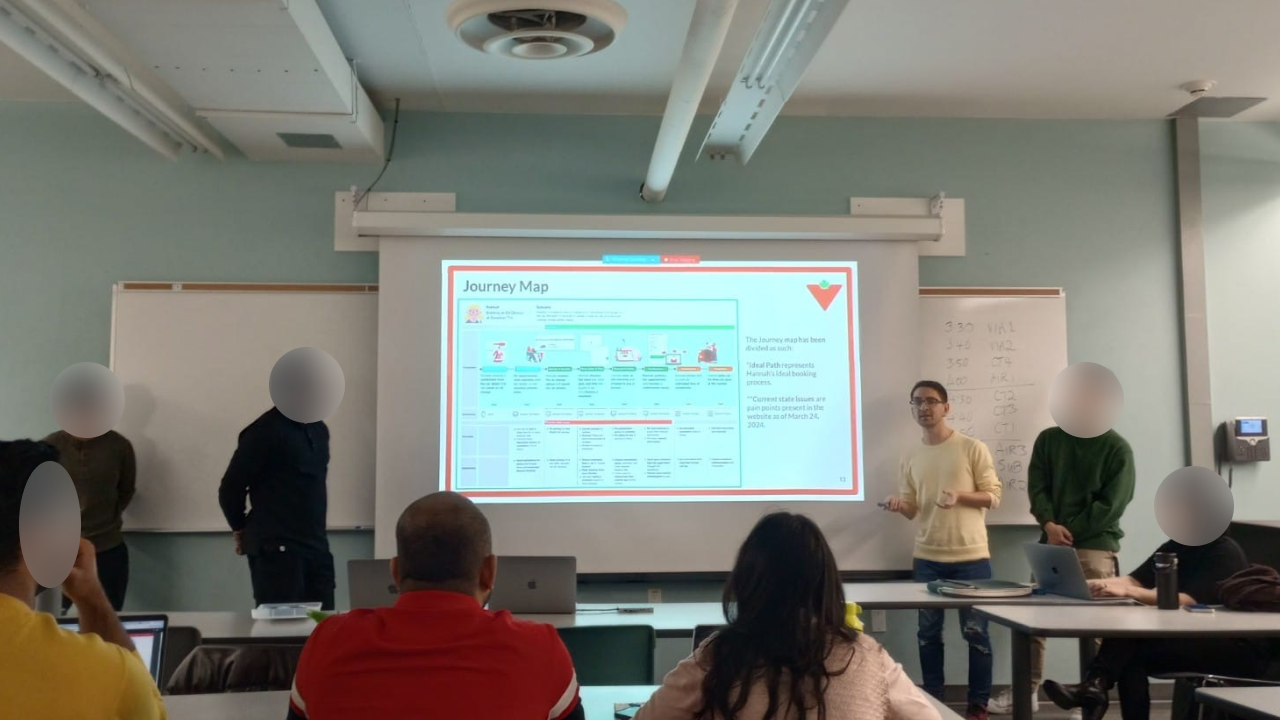Improving the booking process for Canadian Tire
Canadian Tire Auto Booking Service Research
The goal for our team was to find out what makes the best online booking tool
for their online auto booking servic by conducting a competitive analysis,
heuristic analysis on the website, and a round of interviews followed by artifacts
like personas and journey maps.
Industry
Retail
Role & Team
UX Researcher, Team of 4
What I did
Project Statement
Improving online Booking
Canadian Tire is a Canadian brand focused on selling products for outdoor and indoor home
and hardware needs as well as sports and automotive equipment during all four seasons.
The purpose of the project was to investigate the current state of the Canadian Tire Auto Booking
Service and come up with actionable recommendations.
My Role
The team consisted of 4 UX designers, including myself. I was involved in coming up with hypotheses,
research questions, synthesizing data into personas, journey maps, and writing
and editing reports for submission. I also conducted competitive analysis and interviews.
Our Participants
The target participants for our research were car owners who book their oil changes or other
car related services online infrequently, or semi frequently.
Research Process
Competitive Analysis
Initially, I conducted competitive analysis comparing our client, Canadian Tire, to Home Depot
and Walmart, who are both solidified in the home and retail space, to gain an understanding
of where Canadian Tire can improve. The findings below impact the Company's revenue generation and
brand loyalty.
Main Findings
1. Canadian Tire has inconsistent or incomplete inventory management.
2. Canadian Tire has key purchase path issues
3. Canadian Tire has key usability issues regarding its online auto booking service.
As a team, we pitched to conduct further research into the rewards system, purchase path, and auto booking service
as these are key to Canadian Tire’s business success in terms of revenue generation, brand loyalty,
and unique value proposition respectively. Ultimately, we landed on the opportunity to conduct research
on the auto booking service.
Designing a Research Plan
Next, we created a research plan where we would conduct interviews as our main method.
Based on our previous secondary research, we hypothesized that the current booking portal
lacks clarity of information and features that result in our target audience choosing to use
other services. This is something we hoped to learn through further research.
Our Research Questions:
1. What functions and features make the best online booking experience?
2. What factors affect users' ability to effectively use booking services?
3. Why would users choose competing services over the Canadian Tire?
Screener & Discussion Guide
As part of our interview plan, we created a screener and discussion guide to be
used for recruiting and our interview sessions.
Our screener focused on people who owned street legal, motorized vehicles
ages 18-57 who use online booking services both frequently or infrequently.
We screened out those who used public transit, or non-motorized vehicles such
as bikes more frequently than cars.
We created a discussion guide that would serve as the basis for our interviews,
focusing on our participants' positive, negative, and/or ideal online booking
experiences.
Conducting Interviews
Challenges
We conducted 2 interviews each, totalling 8 interviews. Notably, we
had all interviewees draw out their booking process to visually document
their experience as a complementary method to dialogue. As stated, our interview
participants had to be classmates, which do not correctly fit our ideal
recruitment. However, one of my classmates was previously an Uber Driver who
spent lots of time on the road and getting their car maintained. This served as
the majority of my data moving forward as I was lucky enough to get an ideal candidate.
This was my first time conducting interviews. It was pretty challenging trying to
guide a conversation, while asking open-ended questions and listening for key
information, but I enjoyed it and I can’t wait to practice more.
My main findings from my two interviews were as such:
1. Canadian Tire lacks sufficient booking information, causing people to book with other companies.
2. Users want to know exactly what they have to do when they arrive at the service.
3. Last minute, or late booking options are important.
Personas and Journey Mapping
The main findings of my two interview sessions were synthesized into a persona
and journey map, detailing a combination of experiences into one.
One critique of my work in this portion of the project was that I had
put too much information. Next time, I would focus on single sentences
that get to the core of the story rather than step by step to achieve a
more scannable final result.
Combining and Analyzing the Data
As a team, we came together with all 8 of our interviews and their
respective findings to come up with a combined persona and journey map.
We used affinity mapping to synthesize this larger chunk of data.
For this persona and journey map, we wanted to minimize the amount of text and focus
on the most important elements of our story, especially for the journey map.
Main Findings Across All Data
1. The booking portal and in person shop lack communication.
2. The booking portal has insufficient information for users (cancellation policy).
3. The portal lacks flexibility and user choice. The options are rigid.
Final Report and Presentation
Our final report implemented our final recommendations to issues found during our
research, we we had an opportunity to present our findings and outputs in the form of
our revised persona and journey map based on our team's combined efforts.
Our Final Solutions are as follows:
1. Improve notifications and on-site instructions for users through phone or email.
2. Improve clarity on the site, and add more information for users to read.
3. Give users more granular options for their selected service and appointment.
Outcomes and Lessons
From Pain Point to Selling Point
Ultimately, the project was very successfully received by the professor,
noting that the team consistently synthesized complex data into simpler elements.
I was very happy with how the team and I performed, and continually built on our
research to find more and more interesting insights.
For next time, I would love the opportunity to recruit and interview participants
that fit the screener better to get truer insights on the topic. As stated previously,
I had the chance to interview only my classmates, some of which would be screened out
in a real world scenario.
